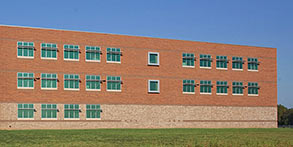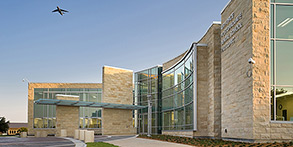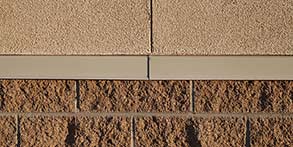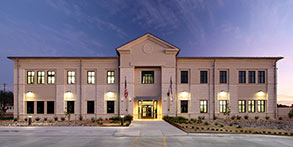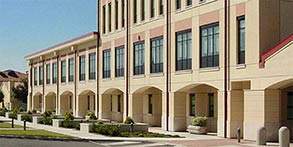- Group 1 facilities may have more refined detailing than Group 2 and Group 2 may have more definition than Group 3.
- Anodized aluminum metal panels may be used in Groups 1 – 3. Metal siding is acceptable for Group 3 facilities and inconspicuous areas of Group 2 facilities.
- Design walls using a hierarchy of primary and secondary wall materials with detailing appropriate for the climate region and use group.
- Limit the number of primary wall materials on a base with each material a consistent color following Installation Facilities Standards (IFS).
- Use materials and detailing not subject to excessive weathering. Provide wall accents consistently throughout a base.
- Use materials in neutral colors, integrally colored materials and factory-finished metals.
Wall systems must be designed for life cycle cost effectiveness and comply with Installation Facilities Standards (IFS) for Facility Groups. Walls will be designed and constructed with durable exterior finishes appropriate for the climate region with detailing that will not show excessive weathering or wear during its life cycle for the specific application. Materials must withstand operations and activities and must tolerate periodic cleaning. Only low-maintenance materials are permitted.
Use of secondary accent materials to complement primary material is encouraged to create a professional-quality appearance and to reduce costs. For typical applications, the use of materials should not be extravagant and increase costs.
All secondary elements of a wall system such as accent materials, relief, lintels, window and door openings, downspouts, joints, etc., will be coordinated with the visual and physical characteristics of the primary wall material.
Sustainability
Following the directives of UFC 1-200-02, evaluate the life-cycle cost effectiveness of passive building components that provide shading, such as wall-mounted fixed shading. Wall systems should enhance indoor environmental quality and must promote thermal comfort, moisture control and daylighting.
Wall materials and detailing should emphasize resource efficiency, respond to the local climate and comply with Base standards. Materials will be appropriate for the specific exposure or orientation of the wall. Material specifications for walls should include consideration of environmentally preferable products, products with recycled content and biologically-based products.
Resilience
Following DoD and AF criteria analyze data and anticipate changes in the climate that will negatively affect the performance and efficiencies of facilities and life-cycle cost effectively develop passive systems, such as fixed shading devices and ground-source heat pump, to reduce energy use. Develop resilience mitigation strategies for building envelopes based on the documented risks.
Evaluate the potential for extreme heat and humidity and provide passive systems such as increased thermal insulation and increased thermal shading as the first priority. Evaluate the potential for extreme cold and provide passive systems such as increased thermal insulation, insulated window shades, and thermal heat storage as the first priority.
Address drought, desertification and ecosystem shifts with acceptable facilities exterior materials.
Respond to high winds, hurricanes and typhoons with appropriately hardened wall systems. Coordinate door and window placement and detailing with the predominant wall material.
Identify areas of potential shift from heating energy to cooling energy and consider passive systems such as solar shading, location of windows and increased insulation as the first priority.
UFC 1-200-01 General Building Requirements https://www.wbdg.org/dod/ufc/ufc-1-200-01
UFC 1-200-02 High Performance and Sustainable Building Requirements https://www.wbdg.org/dod/ufc/ufc-1-200-02
UFC 3-101-01 Architecture https://www.wbdg.org/dod/ufc/ufc-3-101-01

